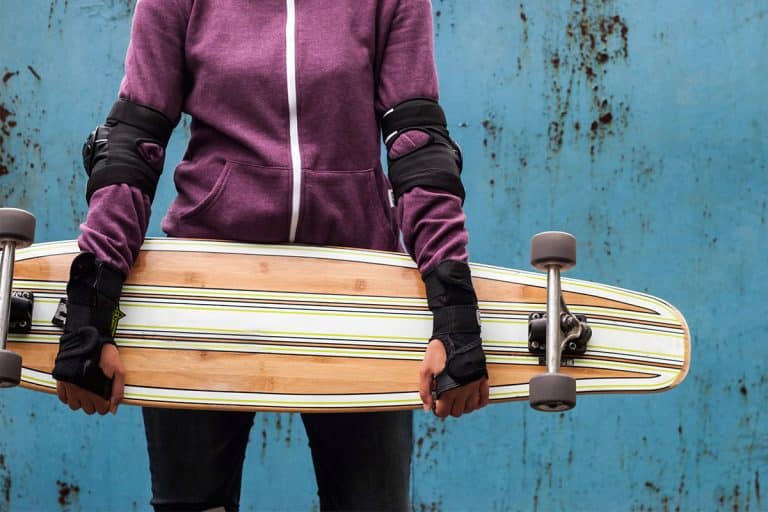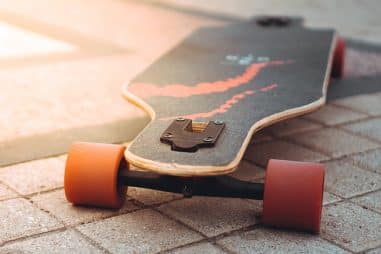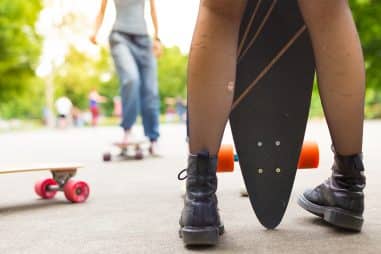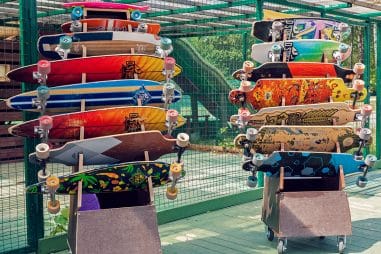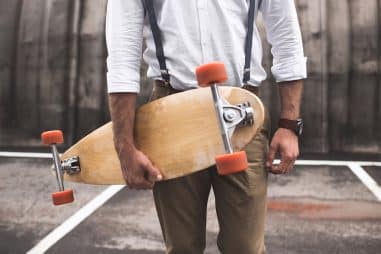The good news is there are a lot of longboards out in the market that you can choose from — big, small, cheap, expensive, freestyle boards, freeride boards, dancers, drop decks, carvers, drop-through, pintails, cruisers, and many, many more.
What Is a Good Longboard for a Beginner?
A good longboard for a beginner should have a relatively flat platform, wide trucks, long wheelbase and a tail. It should be stable and should have ample room for your feet as you learn how to jump on and off the deck.
Aside from all these, what makes a good longboard is that it can easily grow with your capabilities. It would be good to own a board that can still accommodate you when you improve your abilities from beginner to advanced boarder.
What Is the Best Type of Longboard for Beginners?
There is a consensus that the cruiser longboard is the best longboard for beginners. These are often used for transportation. Shorter boards are used for easy commuting while longer boards can be used for bombing hills.
The cruiser longboards come in different shapes, sizes, and deck flex. You can choose one that would serve you well on your riding goals.
However, pro longboarders believe that there is really no such thing as the best longboard for a beginner because the best beginner longboard for you may not be the best for another person.
Which Type of Longboard Is Easiest to Ride?
Cruiser longboards are also often the starting point for boarders, so it follows that it is also the easiest to ride. It is also the most simple and basic out of all the other longboard types.
Cruiser longboards are often shaped like a pintail and the board sits atop the trucks. They also have big wheels which makes the ride easier and smoother.
What Should a Beginner Longboard Look Like?
A beginner longboard should have the following features:
- Stable and durable board
- Light to medium stiffness
- Deck measuring around 30 to 46 inches
- Wheels measuring around 70 to 75 millimeters
- Durometer between 78a to 84a
- Trucks measuring between 150 to 180 millimeters
What Shape of Longboard Is Best for Beginners?
Generally, there are two longboard deck shapes and they are both beginner-friendly.
- Directional Longboards: These boards are only meant to go forward. They are asymmetrical through their horizontal axis. Aside from that, the front and rear sides of the board are not the same. These are often used in slalom and downhill cruise.
- Symmetrical Longboards: These boards are the same on both ends and have horizontal symmetry. Compared to directional, these boards are meant to be ridden either way. These boards are best used for freeride, freestyle, techslide, and dancing. They are often see being used in locations such as street and skate park.
What Size Longboard Is Best for Beginners?
The perfect size longboard depends on your age when you first decide to take up the sport. If you are young-ish or younger, shorter boards are perfect for you. A board measuring about 30 to 32 inches would be perfect for young beginners while regular-sized longboards measuring around 33 to 46 inches would be best for older beginners.
Shorter boards would prove to be best because they would be easy to maneuver for people with less weight. These boards would also be best used in flat pavements and mild downhill areas. They are also good for cruising along sidewalks.
How Much Does a Beginner Longboard Cost?
A good quality longboard can be bought at around 90 to 150 dollars. This is a decent price for a complete set that you would enjoy using and would be sturdy enough for all your beginner fails.
As a beginner, you don’t need the most expensive one, but you also don’t want the cheapest because they would most likely be made with cheap hardware, wheels, and trucks.
How Much Should I Spend on My First Longboard?
If you want to be a serious boarder, you may want to shell out around 150 to 250 dollars for a complete set of a 33 to 43 inch-longboard. This may be a little steep but if you want to be good at it and if you will use it on the daily, then this price will be worth it in the end.
Sure, you can get a longboard for as cheap as 50 dollars but remember that a cheap product is often made with even cheaper hardware. Ultimately, this would make your longboarding experience a lot less enjoyable and might even discourage you from longboarding even further.
How Do I Choose My First Longboard?
If you want to have the best bang for your buck on your first longboard purchase, you may want to pay attention to the following factors and features:
- Budget: First off, decide on how much money you want to spend on your first longboard. Cheaper boards are often low quality. On the other hand, more expensive complete sets would cost you a couple of hundred bucks, but they would last you far longer than a 50-dollar board would.
- Longboard brand: Sometimes the cost of a longboard also depends on its brand. It is because these brands have proven themselves to be reliable and trustworthy in terms of the quality boards that they manufacture.
- Longboard size: The price of longboards varies depending on their size. Smaller longboards and bigger longboards are respectively cheaper and expensive than a regular-sized board. This is because there are fewer materials used for smaller boards. Conversely, bigger boards are made with more materials. Aside from that, the size of the longboard would affect how easily you would learn to ride your longboard . Bigger decks have more room for your feet, and they help you with your balance.
- Longboard shape: The shape of the board would help you specify its riding characteristics. Remember to check the kick tails, wheel cut-outs, and concave.
- Longboard type and riding style: You have to be very clear on how you want to ride your board. Will you be using it mainly for cruising, commuting, or downhill rolling? This would ultimately help you in choosing the best type of longboard for you.
- Longboard flex: The flex ratings of the longboard (often measured by board material, laminates, length, and amount of concave) are categorized into three: soft, medium, and stiff. Soft flex is excellent for shock absorption but is very unstable at medium to high speeds; Medium flex adds pushing potential and is stable even if you are speeding; Stiff flex is most stable at moderate to high speed and is best for freeriding and bombing hills.
- Deck construction: Decide on the type of material used on your board. This factor highly affects the price of your chosen board. Longboards made of bamboo are often more expensive than those made of maple and other woods.
- Deck style: This would tell you how stable the board is and if it is easy to push and stop. Remember that as the deck goes higher, the less stable it becomes and the harder it is to push and to stop. On the other hand, the lower the deck goes, the less leverage you have to do quick carves.
- Wheel type: This is essential in choosing your first board. Wheels are often categorized into two: carved (also called cruise) or freeride (also called slide). Carved or cruise wheels help your grip because of their sharp edges while freeride or slide wheels have more rounded edges. The hardness of the wheel, called the durometer, is also a factor to be considered when buying your board. The smaller the duros, the softer the wheels. Longboard wheels often fall between the 78a to 84a range.
- Wheel size: Beginner longboarders are advised to start with wheels measuring between 70 to 75 millimeters. Smaller wheels will be easier to carve tighter and quicker to take off while bigger wheels have bigger roll speeds. The wideness of the wheel is also a big factor because wider wheels have more contact and grip.
- Trucks: These play a great role because they attach the wheel to the board. They also allow turning and pivoting on the axel. You can adjust the trucks to fit your riding style.
- Bearings: These make your wheels spin. Often rated by the ABEC standard, the higher rating the bearings get, the faster the wheels spin.

